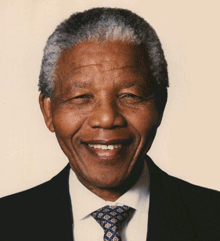Tribute to a Great Man: Nelson Mandela

Nelson Mandela, South Africa, London, apartheid, summer 2007

After twenty-seven years in prison, emerging as a man of singular vision, Nelson Mandela negotiated the dismantling of the apartheid regime in South Africa, settled an agreement on universal suffrage and democratic elections and became the first black President of the country in 1994.
Tribute to a Great Man
Nearly fifty years ago in a very different world, Nelson Mandela walked through central London and dreamt of a statue commemorating a black man among the great and good in Parliament Square. “When Oliver Tambo visited Westminster Abbey and Parliament Square we half joked that one day a statue of a black person would be erected here”.
In summer 2007 his wish came true when, in front of thousands of fans, politicians and celebrities, a bronze sculpture of Nelson Mandela was unveiled taking its rightful place beside the likes of Sir Winston Churchill and Abraham Lincoln. Unveiled by the British Prime Minister, Gordon Brown described his friend as the “greatest leader of his generation … Nelson Mandela is one of the most courageous and best-loved men of all time … This statue demonstrates that no injustice can last for ever.”
Lord Attenborough, British film actor, director and producer, whose 1987 film Cry Freedom highlighted the campaign against apartheid paid tribute to the elderly statesman, calling him affectionately by his tribal name Madiba. “This is a day of celebration, admiration and congratulations. Across the square from Winston Churchill, who led us from fascism, and the great emancipator Abraham Lincoln, we now have Nelson Mandela, the liberator of people.”
Most recently, in 2008 a concert was held in London’s Hyde Park to celebrate the 90th birthday of this great man towards raising funds for the victims of AIDS in Africa, a cause Nelson Mandela has long championed. His presence with thousands of ordinary citizens and celebrities reinforced his dedication to the charities that are involved while bringing home the characteristics of fragility and his lasting charisma and charm.
Liberator of people
In 2007 an elderly and frail Nelson Mandela took to the stage to address the crowd. He said: “We never dreamed we would all be here today. Though this statue is of one man, it should in actual fact symbolise all those who have resisted oppression, especially in my country.”
Mounted on a low plinth the statue brings Nelson Mandela closer to his viewers said to be appropriate for a figure so indelibly associated with democracy. Fittingly, Gordon Brown’s eulogy to this elder statesman added: “Suffering in the cause of freedom will never be in vain. No matter how long the night of oppression, the morning of liberty will break through.”
From Afrikaans, apartheid or apartness, was the policy of separate development of the White and non-White populations in South Africa. From 1948 it pursued a policy of white minority rule (apartheid) which led to international diplomatic, political and economic isolation. A gradual dismantling of the cruel regime began in 1990 following release from prison of the African National Congress leader Nelson Mandela. Majority rule was achieved after the country’s first democratic elections in April 1994, won by the ANC.
Nelson (Rolihlahla) Mandela
Born on 18 July 1918 in Transkei, South Africa, his father was Chief Henry Mandela of the Tembu Tribe. Nelson Mandela studied law and qualified in 1942. He practised law in Johannesburg and was active in the banned African National Congress (ANC). He was in and out of prison and had also been confined to house arrest. He was found not guilty of treason in 1961 but retried 1963-64 and sentenced to life imprisonment. He was incarcerated at Robben Island, a small island near Capetown, used for the detention of political prisoners and then on the mainland, until his release in 1990 by then State President, Willem de Klerk.
He became a potent symbol of resistance as the anti-apartheid movement gathered strength at home and abroad while consistently refusing to compromise his political position to obtain his freedom. Upon release from prison on 11 February 1990 he plunged himself into his life’s work. He was elected President of the ANC while his lifelong friend and colleague Oliver Tambo (1917-93) became the Organisation’s National Chairperson. As leader of the ANC Nelson Mandela engaged in talks on the introduction of majority rule that led to the first democratic elections.
Nelson Mandela shared the Nobel Peace Prize in 1993 with Willem de Klerk …“for their work for the peaceful termination of the apartheid regime, and for laying the foundations for a new democratic South Africa.” … This humanitarian and liberator of people became South Africa’s first democratically elected President from 1994-9.
Amid shouts from the crowd “we love you” the 89 year old South African statesman has long earned a place in his life time deserving to stand tall with the good and great in London’s Parliament Square, as testimony and Tribute to a Great Man.
 Ita Marguet, September 2007
Ita Marguet, September 2007
Note: Acknowledgement is given to all sources used in preparation of this text principally ‘Liberator’ Mandela stands tall in London, U.K. Weekly Telegraph, September, 2007.


